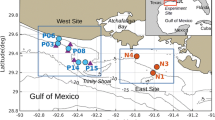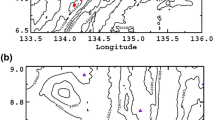Abstract
The magnitude 9.0 Tohoku earthquake on 11 March 2011 generated a tsunami which caused significant impacts throughout the Pacific Ocean. A description of the tsunami within the lagoons and on the surrounding fringing reefs of two mid-ocean atoll islands is presented using bottom pressure observations from the Majuro and Kwajalein atolls in the Marshall Islands, supplemented by tide gauge data in the lagoons and by numerical model simulations in the deep ocean. Although the initial wave arrival was not captured by the pressure sensors, subsequent oscillations on the reef face resemble the deep ocean tsunami signal simulated by two numerical models, suggesting that the tsunami amplitudes over the atoll outer reefs are similar to that in deep water. In contrast, tsunami oscillations in the lagoon are more energetic and long lasting than observed on the reefs or modelled in the deep ocean. The tsunami energy in the Majuro lagoon exhibits persistent peaks in the 30 and 60 min period bands that suggest the excitation of closed and open basin normal modes, while energy in the Kwajalein lagoon spans a broader range of frequencies with weaker, multiple peaks than observed at Majuro, which may be associated with the tsunami behavior within the more irregular geometry of the Kwajalein lagoon. The propagation of the tsunami across the reef flats is shown to be tidally dependent, with amplitudes increasing/decreasing shoreward at high/low tide. The impact of the tsunami on the Marshall Islands was reduced due to the coincidence of peak wave amplitudes with low tide; however, the observed wave amplitudes, particularly in the atoll lagoon, would have led to inundation at different tidal phases.










Similar content being viewed by others
References
Adger, W.N., T.P. Hughes, C. Folke, S.R. Carpenter, and J. Rockström (2005). Social-ecological resilience to coastal disasters, Science, 309, 1036–1039. doi:10.1126/science.1112122.
Allan, J.C., P.D. Komar, P. Ruggiero, and R. Witter (2012). The March 2011 Tōhoku Tsunami and Its Impacts along the US West Coast, J. Coast. Res. 28, 1142–1153. doi:10.2112/JCOASTRES-D-11-00115.1.
Baird, A.H., S.J. Campbell, A.W. Anggoro, R.L. Ardiwijaya, N. Fadli, Y. Herdiana, T. Kartawijaya, D. Mahyiddin, A. Mukminin, and S.T. Pardede (2005). Acehnese reefs in the wake of the Asian tsunami, Curr. Biol., 15, 1926–1930. doi:10.1016/j.cub.2005.09.036.
Borrero, J.C., Bell, R., Csato, C., DeLange, W., Goring, D., Greer, S.D., Pickett, V. and Power, W. (2012). Observations, effects and real time assessment of the March 11, 2011 Tohoku-oki tsunami in New Zealand, Pure and Appl. Geophys., 170, 1229–1248. doi:10.1007/s00024-012-0492-6.
Borrero, J.C. and S.D. Greer (2013). Comparison of the 2010 Chile and 2011 Japan tsunamis in the far field, Pure Appl. Geophys. 170, 1249–1274. doi:10.1007/s00024-012-0559-4.
Chatenoux, B. and P. Peduzzi (2007). Impacts from the 2004 Indian Ocean Tsunami: analysing the potential protecting role of environmental features, Nat. Hazards, 40, 289–304. doi:10.1007/s11069-006-0015-9.
Ford, M.R., J.M. Becker, and M.A. Merrifield (2012). Spatial and temporal controls of atoll island inundation: implications for urbanized atolls in the Marshall Islands. (Invited), 2012 AGU Fall Meeting.
Gelfenbaum, G., A. Apotsos, A.W. Stevens, and B. Jaffe (2011). Effects of fringing reefs on tsunami inundation: American Samoa, Earth-Sci. Rev., 107, 12–22. doi:10.1016/j.earscirev.2010.12.005.
Goff, J., P.L. Liu, B. Higman, R. Morton, B.E. Jaffe, H. Fernando, P. Lynett, H. Fritz, C. Synolakis, and S. Fernando (2006). Sri Lanka field survey after the December 2004 Indian Ocean tsunami, Earthquake Spectra, 22, 155–172. doi:10.1193/1.2205897.
Heidarzadeh, M. and K. Satake (2013). Waveform and spectral analyses of the 2011 Japan tsunami records on tide gauge and DART stations across the Pacific Ocean, Pure Appl. Geophys., 170, 1275–1293. doi:10.1007/s00024-012-0558-5.
Kench, P.S., R.F. McLean, R.W. Brander, S.L. Nichol, S.G. Smithers, M.R. Ford, K.E. Parnell, and M. Aslam (2006). Geological effects of tsunami on mid-ocean atoll islands: The Maldives before and after the Sumatran tsunami, Geology, 34, 177–180. doi:10.1130/G21907.1.
Kunkel, C.M., R.W. Hallberg, and M. Oppenheimer (2006). Coral reefs reduce tsunami impact in model simulations, Geophys. Res. Lett., 33, L23612. doi:10.1029/2006GL027892.
Lugo-Fernández, A., H.H. Roberts, and J.N. Suhayda (1998). Wave transformations across a Caribbean fringing-barrier coral reef, Cont. Shelf Res., 18, 1099–1124.
Lynett, P.J. (2007). Effect of a shallow water obstruction on long wave runup and overland flow velocity, J. of Waterway, Port, Coastal, and Ocean Eng., 133, 455–462. doi:10.1061/(ASCE)0733-950X(2007)133:6(455).
Merrifield, M., Y. Firing, T. Aarup, W. Agricole, G. Brundrit, D. Chang-Seng, R. Farre, B. Kilonsky, W. Knight, and L. Kong (2005). Tide gauge observations of the Indian Ocean tsunami, December 26, 2004, Geophys. Res. Lett., 32, L09603. doi:10.1029/2005GL022610.
Mori, N., T. Takahashi, T. Yasuda, and H. Yanagisawa (2011). Survey of 2011 Tohoku earthquake tsunami inundation and run-up, Geophys. Res. Lett., 38, L00G14. doi:10.1029/2011GL049210.
National Geophysical Data Center (NGDC) (2012). March 11, 2011 Japan Earthquake and Tsunami. http://www.ngdc.noaa.gov/hazard/honshu_11mar2011.shtml. Accessed 09/28/2013.
Péquignet, A., J. Becker, M. Merrifield, and S. Boc (2011). The dissipation of wind wave energy across a fringing reef at Ipan, Guam, Coral Reefs, 30(1), 71–82. doi:10.1007/s00338-011-0719-5.
Rabinovich, A.B., R.E. Thomson, and F.E. Stephenson (2006). The Sumatra tsunami of 26 December 2004 as observed in the North Pacific and North Atlantic oceans, Surv. Geophys., 27(6), 647–677. doi:10.1007/s10712-006-9000-9.
Rabinovich, A.B. and R.E. Thomson (2007). The 26 December 2004 Sumatra tsunami: Analysis of tide gauge data from the world ocean Part 1. Indian Ocean and South Africa. Pure Appl. Geophys. 164, 261–308. doi:10.1007/s00024-006-0164-5.
Rabinovich, A., K. Stroker, R. Thomson, and E. Davis (2011). DARTs and CORK in Cascadia Basin: High-resolution observations of the 2004 Sumatra tsunami in the northeast Pacific, Geophys. Res. Lett., 38(8), L08607. doi:10.1029/2011GL047026.
Rabinovich, A.B., R.N. Candella, and R.E. Thomson (2013). The open ocean energy decay of three recent trans-Pacific tsunamis, Geophys. Res. Lett. 40, 3157–3162. doi:10.1002/grl.50625.
Shevchenko, G., T. Ivelskaya, and A. Loskutov (2014). Characteristics of the 2011 Great Tohoku Tsunami on the Russian Far East Coast: Deep-Water and Coastal Observations, Pure Appl. Geophys., 1–22. doi:10.1007/s00024-013-0727-1.
Song, Y.T. and T.Y. Hou (2006). Parametric vertical coordinate formulation for multiscale, Boussinesq, and non-Boussinesq ocean modeling, Ocean Modelling, 11(3), 298–332. doi:10.1016/j.ocemod.2005.01.001.
Song, Y.T., L. Fu, V. Zlotnicki, C. Ji, V. Hjorleifsdottir, C. Shum, and Y. Yi (2008). The role of horizontal impulses of the faulting continental slope in generating the 26 December 2004 tsunami, Ocean Modelling, 20(4), 362–379. doi:10.1016/j.ocemod.2007.10.007.
Song, Y.T., I. Fukumori, C. Shum, and Y. Yi (2012). Merging tsunamis of the 2011 Tohoku-Oki earthquake detected over the open ocean, Geophys. Res. Lett., 39(5). doi:10.1029/2011GL050767.
Spennemann, D.H. (1996). Nontraditional settlement patterns and typhoon hazard on contemporary Majuro atoll, Republic of the Marshall Islands, Environ. Manage., 20, 337–348.
Tang, L., V.V. Titov, E.N. Bernard, Y. Wei, C.D. Chamberlin, J.C. Newman, H.O. Mofjeld, D. Arcas, M.C. Eble, and C. Moore (2012). Direct energy estimation of the 2011 Japan tsunami using deep-ocean pressure measurements, J. Geophys. Res., 117(C8). doi:10.1029/2011JC007635.
Titov, V. and F. Gonzalez (1997). Implementation and testing of the Method of Splitting Tsunami (MOST) model, NOAA Tech. Memo. ERL PMEL-112 (PB98-122773), NOAA/Pacific Marine Environmental Laboratory, Seattle, WA, 11 pp.
Torrence, C. and G.P. Compo (1998). A practical guide to wavelet analysis, Bull. Am. Meteorol. Soc., 79, 61–78.
U.S. Fish and Wildlife Service (2011). Seabird loses at Midway Atoll Wildlife Refuge greatly exceed early estimates. Press Release, 18th March 2011.
Van Dorn, W. (1984). Some tsunami characteristics deducible from tide records, J. of Phys.Ocean., 14, 353–363.
Wilson, R.I., A.R. Admire, J.C. Borrero, L.A. Dengler, M.R. Legg, P. Lynett, T.P. McCrink, K.M. Miller, A. Ritchie, and K. Sterling (2012). Observations and impacts from the 2010 Chilean and 2011 Japanese tsunamis in California (USA), Pure Appl. Geophys., 170, 1127–1147. doi:10.1007/s00024-012-0527-z.
Woodroffe, C.D. (2008). Reef-island topography and the vulnerability of atolls to sea-level rise, Global Planet. Change, 62, 77–96. doi:10.1016/j.gloplacha.2007.11.001.
Yamazaki, Y., K.F. Cheung, G. Pawlak, and T. Lay (2012). Surges along the Honolulu coast from the 2011 Tohoku tsunami, Geophys. Res. Lett., 39: L09604. doi:10.1029/2012GL051624.
Acknowledgments
This study was supported by a grant from the National Science Foundation (OCE-0927407). DART buoy data were obtained from the NOAA National Data Buoy Center (http://www.ndbc.noaa.gov/dar.shtml), Kwajalein tide gauge data from the NOAA Center for Operational Oceanographic Products and Services (http://tidesandcurrents.noaa.gov), and Majuro tide gauge data from the National Tidal Centre, Australia. Comments by Alexander Rabinovich and two anonymous reviewers greatly improved the manuscript. We thank Rachel Tang for the MOST model data. Christopher Kontoes, Carly Fetherolf, and Derek Young were responsible for the Marshall Islands field observations. Hyang Yoon provided graphics and data processing support.
Author information
Authors and Affiliations
Corresponding author
Rights and permissions
About this article
Cite this article
Ford, M., Becker, J.M., Merrifield, M.A. et al. Marshall Islands Fringing Reef and Atoll Lagoon Observations of the Tohoku Tsunami. Pure Appl. Geophys. 171, 3351–3363 (2014). https://doi.org/10.1007/s00024-013-0757-8
Received:
Revised:
Accepted:
Published:
Issue Date:
DOI: https://doi.org/10.1007/s00024-013-0757-8




